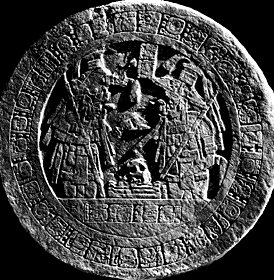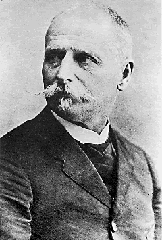|
By the turn of the century, Teobert Maler, an Austrian-born photographer and adventurer, had produced a vast treasury of photographs depicting many previously unrecorded Maya sites in Mexico and Guatemala. Maler's work provided an important stimulus to the development of Maya archaeology, and remains a unique source of material for epigraphic, iconographic, and architectural studies.
Born in 1842, Maler came to Mexico in 1864 as a young volunteer in the Austrian military expedition supporting the imperial claims of Archduke Maximilian. Maler's military career ended when Maximilian was toppled in 1867, but by then the beauty of Mexico held him captive. He made the country his adoptive home, and the documentation of its Maya heritage became his lifework. |
|
Photographing ancient sites was expensive work, and Maler
had to devise new ways of making money from his growing
collection of prints. For some years he had sold prints of
Yucatan ruins, but the sale of single images failed to meet his
financial needs. Similarly, the occasional article that he
contributed to the German geographic and ethnographic magazine
Globus and other journals cannot have satisfied his desire to
make an enduring contribution to archaeology.
To boost his income, as well as his reputation in academic circles, Maler began preparing sets of large prints, uniformly mounted, supplemented by site plans and other information, and intended for sale to museums and universities. In seeking buyers for his prints, he came to the attention of Harvard's Peabody Museum, which quickly put him to work. Early in 1898, Maler set out on his first expedition under the auspices of the Peabody-a survey in the region of Palenque. It was the first of three major expeditions that he undertook for the museum between 1898 and 1905. Maler's headstrong temperament, which had served him well as an explorer, worked to his disadvantage in his dealings with the Peabody, and he ended his association with the institution in 1909. He spent his later years in Merida, where he died on November 22, 1917. Although a large number of Maler's photographs and plans of Maya ruins have already been published, one large body of his work has lain for decades in the Ibero-Amerikanisches Institut, Berlin, without attracting much attention. The Institute's Hanns Prem is now preparing for publication three volumes, titled Peninsula Yucatan, based on notebooks of Maler's that contain about 400 manuscript pages and photographs illustrating some 100 sites, many of them never since visited by archaeologists. Additional unpublished photographs, including many from Maler's first period in Mexico, are in the collections of the Peabody Museum at Harvard. As an expeditionary photographer, Maler was unsurpassed. He had the skill to adjust exposures so as to render details in both light as well as shadow. He used considerable judgment in composing pictures, and often enhanced them with the figures of men working in the foreground, leaning against a doorway, or seated on the ground. His technical prowess shows, too, in the enlargements he made on platinum paper, an extremely difficult printing technique to use in a tropical climate, and in a primitive darkroom. The perfection Maler strove for is exemplified in his photographs of fragmented monuments. He would photograph a broken monument piece by piece, taking pains to keep the lens-to-object distance constant, thus ensuring a uniform scale. After trimming each negative to eliminate the background, he would assemble the individual negatives, cement them to a sheet of clear film-base, and from this composite negative make a print of the "reassembled" monument. Teobert Maler was a loner. Had he been married, he might not have made his long expeditions. It would be wrong to suggest that heads of families in Victorian times never went on dangerous or extended expeditions, for they did. But the kind of concentrated activity that Maler maintained for 20 years would have been highly unusual for a family man. Maler's writings, as well as descriptions of him by contemporaries, suggest a cantankerous personality capable of sustaining long feuds. For one thing, he was jealous of virtually all other archaeologists. His favorite target was the American Mayanist Edward H. Thompson, with whom he carried on a vitriolic and rather one-sided feud for 25 years. Thompson's offense was to "trespass" on sites like Labna and Chichen Itza that Maler considered his own. He was certainly jealous, too, of his great contemporary Alfred Maudslay, whom he could scarcely forgive for having reached Menche (or Yaxchilan) before he could get there. The fact that Maudslay removed pieces of sculpture, now in the British Museum, from those ruins provided Maler with an excellent cause for complaint. Yet, rather than attack the eminent Maudslay, Maler directed his scorn toward Maudslay's assistant, Gorgonio Lopez. Maler was equally reluctant to give credit to others, even to those not in direct competition with him. Indeed it may not be too much of an exaggeration to suggest that he aspired to the grandiose notion of being the sole discoverer of the Maya. In fact, the interpretive comments in his reports on the Maya are at times mere guesswork (he assumed that a certain solidly constructed building at Dsibiltun in Campeche was the Tlatocan, or House of Justice, when its original function is not at all certain) and sometimes quaintly racist (he felt the people of Mexico owed their vigor to their descent from Turkic tribes). At times Maler was merely credulous. He believed in the lost continent of Atlantis and spoke of having discovered, on the wall of a buried Maya chamber, a mural depicting the destruction of Atlantis, "a water scene with a volcano spouting fire and smoke, buildings falling into the water, people drowning," as he described it. His eccentricities, however, pale beside his accomplishments. Maler has long been recognized as one of the two great archaeological explorers active in the Maya area at the dawn of professional studies in Mesoamerican history, the other being Alfred Maudslay. Had it not been for them, later scholars would have been seriously handicapped by a lack of reliable data, and the development of Maya archaeology would have been delayed by decades. |

